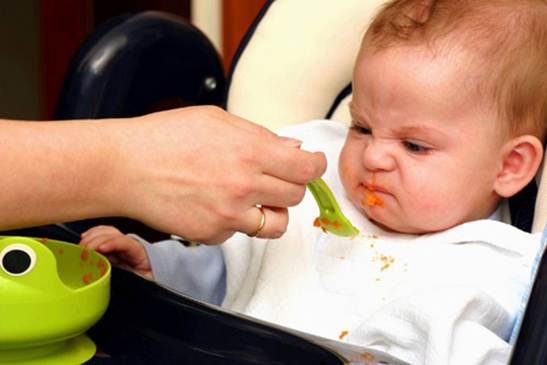Children seem to hate pumpkins/carrots/apples…

The fact that
children aren’t cooperative in eating foods doesn’t mean they hate the foods.
When children try new foods, they often shake their heads,
spill the foods out or cry. We often take that as children hate the foods. In
fact, it’s not like that. Specialists studying on infants say that infants have
to eat a food 15-20 times to know whether they like it or not. If you fail in
feeding children one food for once or twice, don’t rush in ending up that
children hate the food.
In the early time of the weaning, you can see funny
expressions of your babies, such as grimace, biting lips or insisting on
shutting the mouth when you feed them. This is simply that children are
considering the structures and tastes of the new foods. Remember that you
children have just been used to being breastfed in the last 6 months and never
seen any foods until they start weaning; they must be confused a little.
Store the foods babies don’t like in the fridge and let them
try it again at another time, start with a small amount.
The first weaning food is loose gruel

Any natural food
can be children’s first weaning food.
Loose gruel has been a weaning food for a long time. Why is
that? That’s because rice and grains are generally safe, hypoallergenic, easy
to eat and make, and contain a good deal of essential iron, vitamins and
minerals for children.
However, children who are on weaning aren’t supposed to eat
rice firstly. Practically, children from countries have different weaning foods
which are harmless for their digestive system. The soft, purred state of any food
like vegetables, potatoes, carrots, avocadoes, bananas… can all be children’s
first weaning foods. Even it’s a spoon if lean pork is fine. Any natural food
can be children’s first weaning food.
Not letting children have greasy foods as their digestive systems are
unable to absorb foods
Many people avoid feeding their children on meat with
tallow, cooking oil because they’re afraid their children will have obesity or digestive
disorders. Children’s absorption doesn’t practically happen like that.Children need
about 30-40% of calories from fat they absorb daily to supply for their brains
and bodies that are in great speed of the development. That’s because the
brains have special needs of fatty acids and other components of fat.
The appropriate amount of fat for children who are under 1
year old is 3.5 over 1 kg of weight every day. It’d be better if children have
fat from vegetable tallow and fish fat which have a high content of Omega 3;
the Omega 3 can increase children’s immunity, reduce the risk of infectious
diseases, and support the circulation. Therefore, children should have olive
oil, Gac oil or vegetable oil with weaning foods.